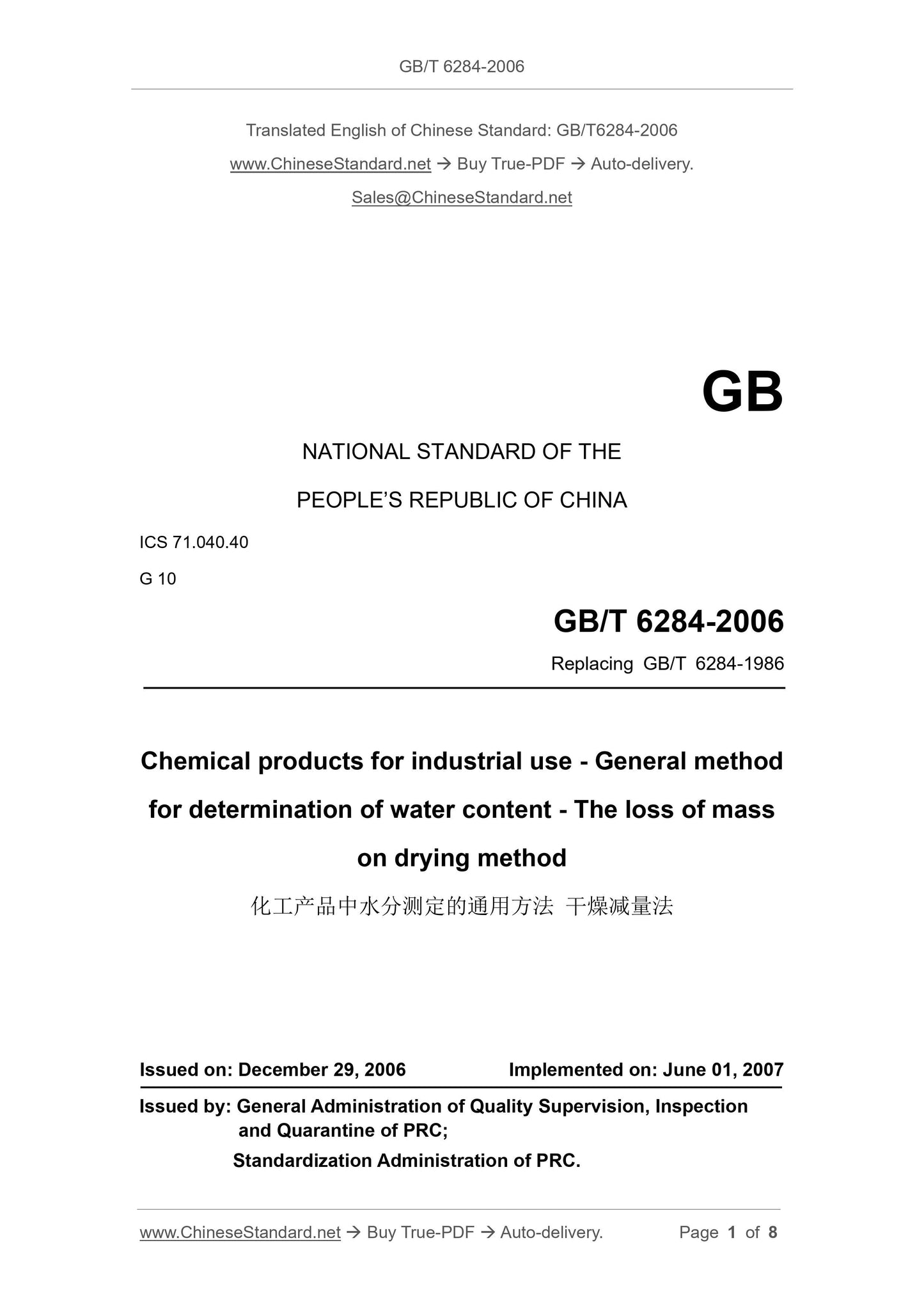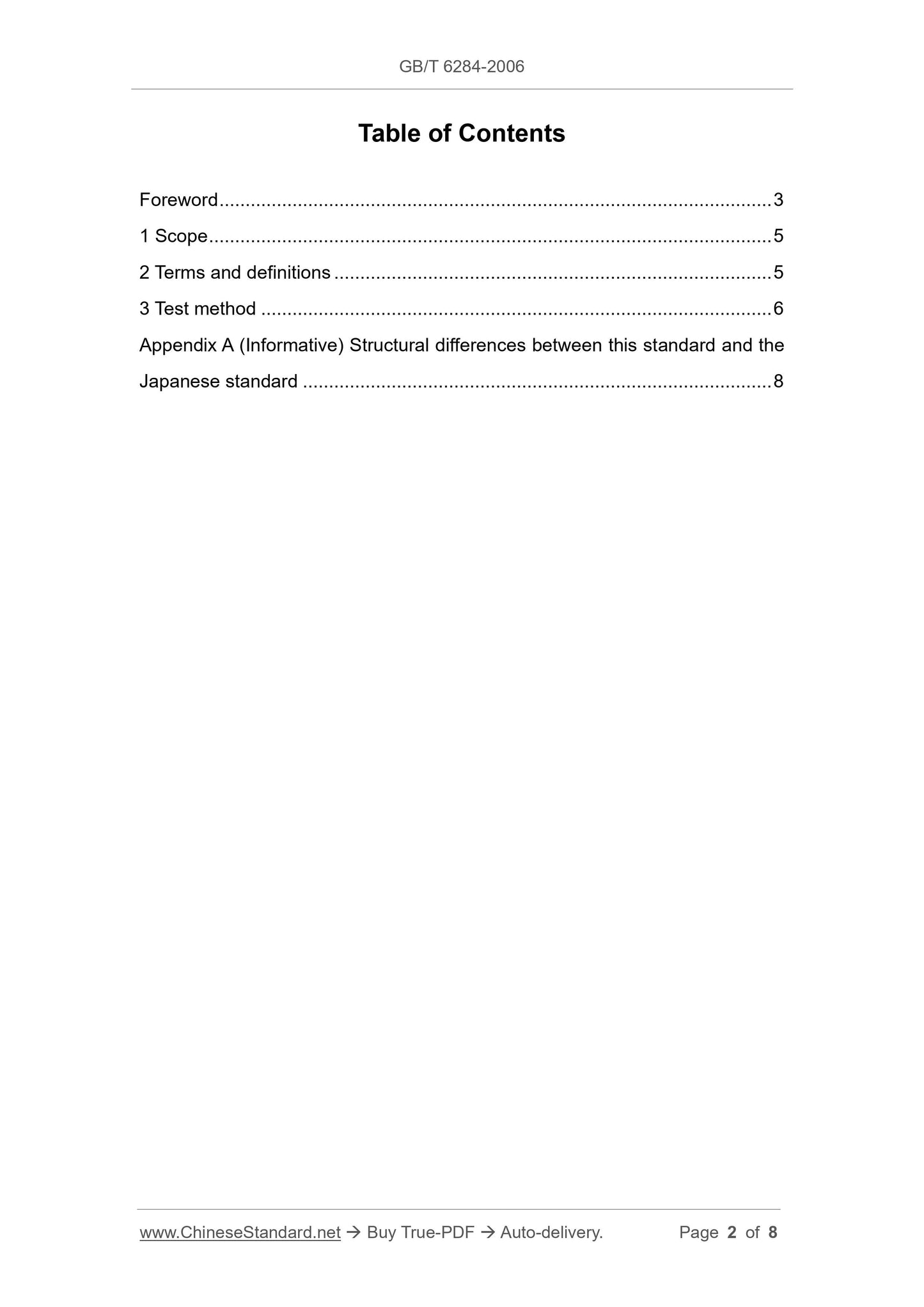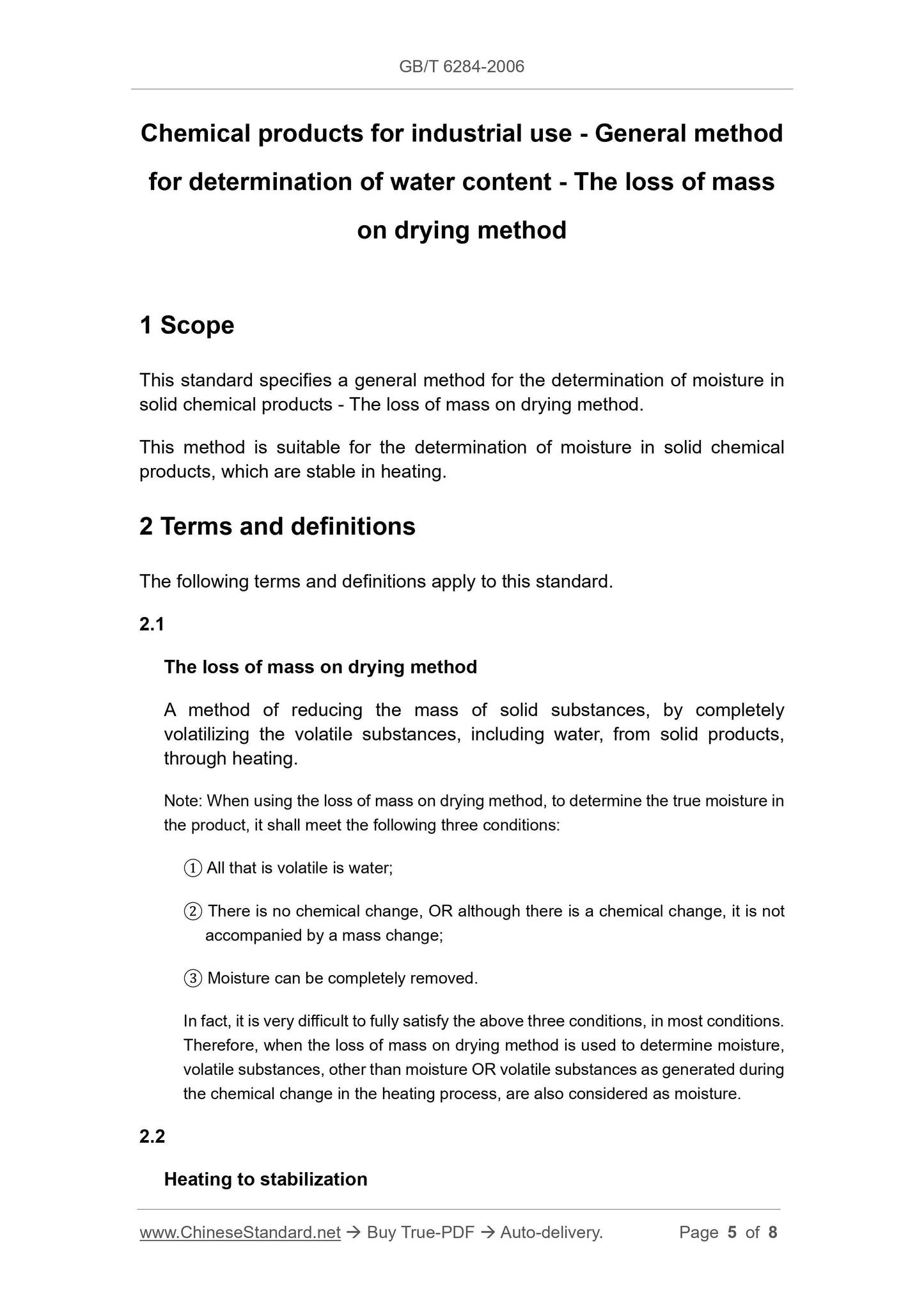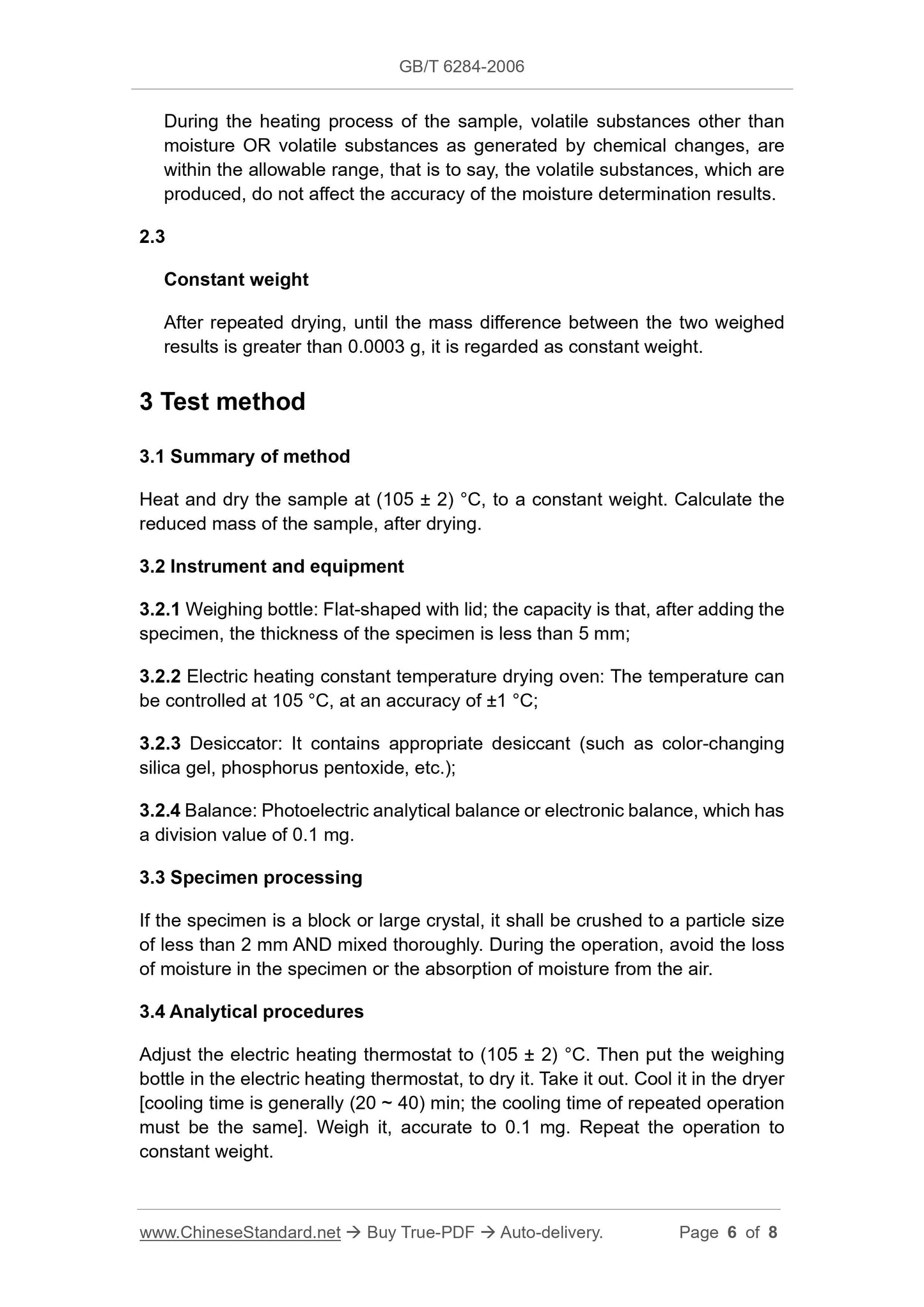1
/
of
4
PayPal, credit cards. Download editable-PDF and invoice in 1 second!
GB/T 6284-2006 English PDF (GBT6284-2006)
GB/T 6284-2006 English PDF (GBT6284-2006)
Regular price
$115.00 USD
Regular price
Sale price
$115.00 USD
Unit price
/
per
Shipping calculated at checkout.
Couldn't load pickup availability
Delivery: 3 seconds. Download true-PDF + Invoice.
Get QUOTATION in 1-minute: Click GB/T 6284-2006
Historical versions: GB/T 6284-2006
Preview True-PDF (Reload/Scroll if blank)
GB/T 6284-2006: Chemical products for industrial use -- General method for determination of water content -- The loss of mass on drying method
GB/T 6284-2006
GB
NATIONAL STANDARD OF THE
PEOPLE’S REPUBLIC OF CHINA
ICS 71.040.40
G 10
Replacing GB/T 6284-1986
Chemical products for industrial use - General method
for determination of water content - The loss of mass
on drying method
ISSUED ON: DECEMBER 29, 2006
IMPLEMENTED ON: JUNE 01, 2007
Issued by: General Administration of Quality Supervision, Inspection
and Quarantine of PRC;
Standardization Administration of PRC.
Table of Contents
Foreword ... 3
1 Scope ... 5
2 Terms and definitions ... 5
3 Test method ... 6
Appendix A (Informative) Structural differences between this standard and the
Japanese standard ... 8
Chemical products for industrial use - General method
for determination of water content - The loss of mass
on drying method
1 Scope
This standard specifies a general method for the determination of moisture in
solid chemical products - The loss of mass on drying method.
This method is suitable for the determination of moisture in solid chemical
products, which are stable in heating.
2 Terms and definitions
The following terms and definitions apply to this standard.
2.1
The loss of mass on drying method
A method of reducing the mass of solid substances, by completely
volatilizing the volatile substances, including water, from solid products,
through heating.
Note: When using the loss of mass on drying method, to determine the true moisture in
the product, it shall meet the following three conditions:
① All that is volatile is water;
② There is no chemical change, OR although there is a chemical change, it is not
accompanied by a mass change;
③ Moisture can be completely removed.
In fact, it is very difficult to fully satisfy the above three conditions, in most conditions.
Therefore, when the loss of mass on drying method is used to determine moisture,
volatile substances, other than moisture OR volatile substances as generated during
the chemical change in the heating process, are also considered as moisture.
2.2
Heating to stabilization
During the heating process of the sample, volatile substances other than
moisture OR volatile substances as generated by chemical changes, are
within the allowable range, that is to say, the volatile substances, which are
produced, do not affect the accuracy of the moisture determination results.
2.3
Constant weight
After repeated drying, until the mass difference between the two weighed
results is greater than 0.0003 g, it is regarded as constant weight.
3 Test method
3.1 Summary of method
Heat and dry the sample at (105 ± 2) °C, to a constant weight. Calculate the
reduced mass of the sample, after drying.
3.2 Instrument and equipment
3.2.1 Weighing bottle: Flat-shaped with lid; the capacity is that, after adding the
specimen, the thickness of the specimen is less than 5 mm;
3.2.2 Electric heating constant temperature drying oven: The temperature can
be controlled at 105 °C, at an accuracy of ±1 °C;
3.2.3 Desiccator: It contains appropriate desiccant (such as color-changing
silica gel, phosphorus pentoxide, etc.);
3.2.4 Balance: Photoelectric analytical balance or electronic balance, which has
a division value of 0.1 mg.
3.3 Specimen processing
If the specimen is a block or large crystal, it shall be crushed to a particle size
of less than 2 mm AND mixed thoroughly. During the operation, avoid the loss
of moisture in the specimen or the absorption of moisture from the air.
3.4 Analytical procedures
Adjust the electric heating thermostat to (105 ± 2) °C. Then put the weighing
bottle in the electric heating thermostat, to dry it. Take it out. Cool it in the dryer
[cooling time is generally (20 ~ 40) min; the cooling time of repeated operation
must be the same]. Weigh it, accurate to 0.1 mg. Repeat the operation to
constant weight.
Get QUOTATION in 1-minute: Click GB/T 6284-2006
Historical versions: GB/T 6284-2006
Preview True-PDF (Reload/Scroll if blank)
GB/T 6284-2006: Chemical products for industrial use -- General method for determination of water content -- The loss of mass on drying method
GB/T 6284-2006
GB
NATIONAL STANDARD OF THE
PEOPLE’S REPUBLIC OF CHINA
ICS 71.040.40
G 10
Replacing GB/T 6284-1986
Chemical products for industrial use - General method
for determination of water content - The loss of mass
on drying method
ISSUED ON: DECEMBER 29, 2006
IMPLEMENTED ON: JUNE 01, 2007
Issued by: General Administration of Quality Supervision, Inspection
and Quarantine of PRC;
Standardization Administration of PRC.
Table of Contents
Foreword ... 3
1 Scope ... 5
2 Terms and definitions ... 5
3 Test method ... 6
Appendix A (Informative) Structural differences between this standard and the
Japanese standard ... 8
Chemical products for industrial use - General method
for determination of water content - The loss of mass
on drying method
1 Scope
This standard specifies a general method for the determination of moisture in
solid chemical products - The loss of mass on drying method.
This method is suitable for the determination of moisture in solid chemical
products, which are stable in heating.
2 Terms and definitions
The following terms and definitions apply to this standard.
2.1
The loss of mass on drying method
A method of reducing the mass of solid substances, by completely
volatilizing the volatile substances, including water, from solid products,
through heating.
Note: When using the loss of mass on drying method, to determine the true moisture in
the product, it shall meet the following three conditions:
① All that is volatile is water;
② There is no chemical change, OR although there is a chemical change, it is not
accompanied by a mass change;
③ Moisture can be completely removed.
In fact, it is very difficult to fully satisfy the above three conditions, in most conditions.
Therefore, when the loss of mass on drying method is used to determine moisture,
volatile substances, other than moisture OR volatile substances as generated during
the chemical change in the heating process, are also considered as moisture.
2.2
Heating to stabilization
During the heating process of the sample, volatile substances other than
moisture OR volatile substances as generated by chemical changes, are
within the allowable range, that is to say, the volatile substances, which are
produced, do not affect the accuracy of the moisture determination results.
2.3
Constant weight
After repeated drying, until the mass difference between the two weighed
results is greater than 0.0003 g, it is regarded as constant weight.
3 Test method
3.1 Summary of method
Heat and dry the sample at (105 ± 2) °C, to a constant weight. Calculate the
reduced mass of the sample, after drying.
3.2 Instrument and equipment
3.2.1 Weighing bottle: Flat-shaped with lid; the capacity is that, after adding the
specimen, the thickness of the specimen is less than 5 mm;
3.2.2 Electric heating constant temperature drying oven: The temperature can
be controlled at 105 °C, at an accuracy of ±1 °C;
3.2.3 Desiccator: It contains appropriate desiccant (such as color-changing
silica gel, phosphorus pentoxide, etc.);
3.2.4 Balance: Photoelectric analytical balance or electronic balance, which has
a division value of 0.1 mg.
3.3 Specimen processing
If the specimen is a block or large crystal, it shall be crushed to a particle size
of less than 2 mm AND mixed thoroughly. During the operation, avoid the loss
of moisture in the specimen or the absorption of moisture from the air.
3.4 Analytical procedures
Adjust the electric heating thermostat to (105 ± 2) °C. Then put the weighing
bottle in the electric heating thermostat, to dry it. Take it out. Cool it in the dryer
[cooling time is generally (20 ~ 40) min; the cooling time of repeated operation
must be the same]. Weigh it, accurate to 0.1 mg. Repeat the operation to
constant weight.
Share








